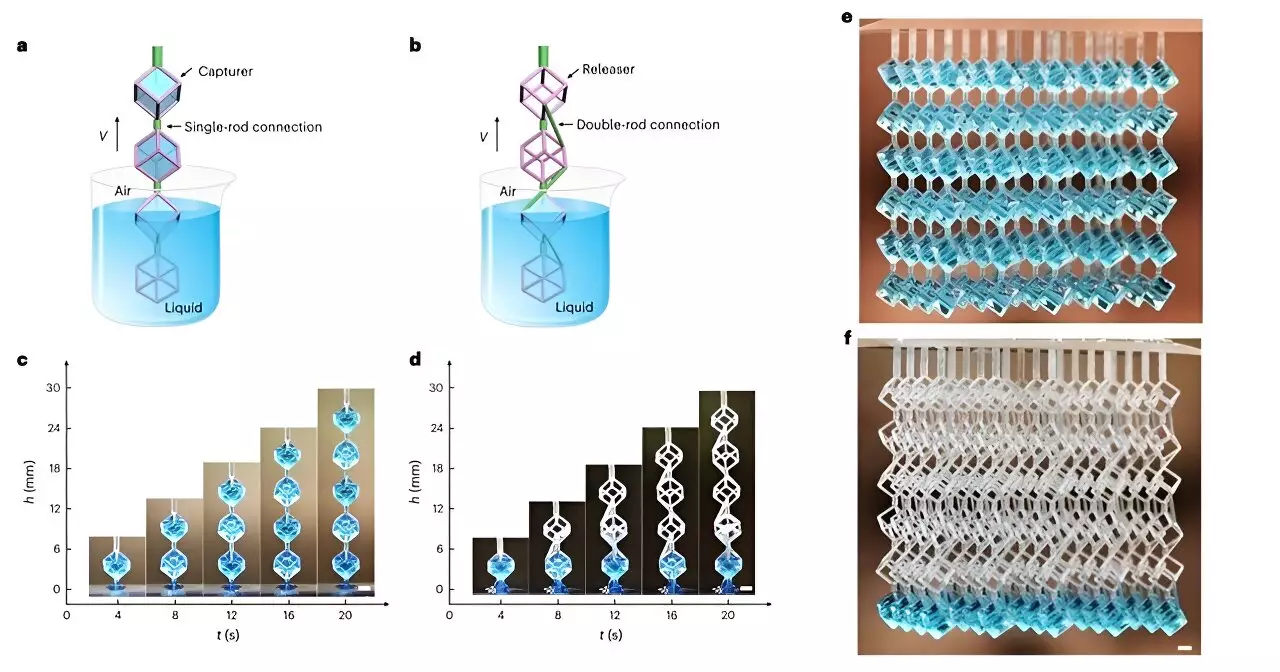Fluidic technologies are the backbone of numerous industries, from healthcare to energy. The efficient manipulation of liquids—be it capturing, releasing, or transporting—is crucial for advancements in diverse fields such as pharmaceuticals, biotechnology, and environmental sustainability. Despite the importance of these technologies, achieving precision in fluid handling has long posed significant challenges. A recent innovative breakthrough by a research team at The Polytechnic University of Hong Kong (PolyU) has shown promise in addressing these issues through a remarkable fluid management platform known as “Connected Polyhedral Frames” (CPFs).
In many professional applications, liquids can be notoriously difficult to control. Conventional methods often face limitations, particularly concerning volumetric accuracy and contamination. The interaction between fluids and materials can lead to unwanted wetting and spreading, making it difficult to ensure that liquids are transferred efficiently and accurately. Additionally, reliance on disposable plastic tools such as pipettes contributes to escalating global plastic waste problems. A solution is necessary that allows not only for the effective handling of fluids but also minimizes environmental impact.
The research, led by Prof. Wang Liqiu and documented in the esteemed journal Nature Chemical Engineering, introduces CPFs, a novel fluidic processor characterized by its revolutionary approach to liquid management. This innovative system allows for reversible switching between capturing and releasing fluids, making it both programmable and adaptable to various liquid types. Importantly, CPFs do not impose restrictions based on the materials utilized in their structure or the types of fluids handled, making them true meta-metamaterials.
CPFs consist of frames that operate via a unique mechanism: those positioned above a single-rod connection are designed to capture and retain liquids, while frames located above a double-rod connection facilitate liquid release. This design solves the issue of liquid drainage between frames, transforming lines of liquid into channels that can be managed with precision.
The versatility of CPFs allows for a myriad of applications across different fields. Researchers have demonstrated the capability of these fluidic processors to achieve intricate 3D patterning of liquids and manage multiple material concentrations with great accuracy. This scalability allows for significant advancements in both research and industrial settings, as the CPFs can handle an extensive range of fluids—from biofluids and hydrogels to organic solvents and oils.
In a compelling application, the PolyU team designed a CPF network to control the release of vitamins B2 and B12, encapsulated in distinct hydrogel environments. By adjusting the thickness of the gel membranes, the rate of release for each vitamin could be finely tuned, enabling improved delivery of these essential compounds.
Conventional sampling tools, including cotton swabs and flocking swabs, often leave behind significant amounts of residue after use, compromising sample accuracy. This is where CPFs demonstrate their profound advantage. By providing liquid-liquid interfaces that enhance release efficiency, CPFs have shown superior performance in biological sample collection. When tested with the influenza virus, CPFs effectively detected the virus at lower concentrations than traditional swabs, showcasing their potential in diagnostics and research.
Furthermore, when focusing on the encapsulation of biological materials, such as the bacteria Acetobacterium, CPFs facilitated a more efficient microbial reaction process. The unique design of CPFs allows for a separation of bacteria from reaction products, enhancing product yield while simplifying operational complexity.
The applications of CPFs extend well beyond the medical field. Researchers are exploring their use in environmental technologies, specifically in air conditioning systems. A prototype humidifier developed using CPFs has demonstrated an increase in water storage capacity while requiring less flow, which may lead to improved energy efficiency in commercial systems.
Additionally, the larger surface area formed through the 3D liquid dispersion capabilities of CPFs has the potential to enhance gas absorption processes, making them suitable for carbon capture and storage initiatives. By employing CPFs in carbon cycle processes, researchers are potentially revolutionizing how we manage greenhouse gas emissions.
The development of CPFs represents a significant milestone in fluidic technology, ultimately offering a new standard for liquid manipulation. The ability to switch between capturing and releasing liquids with precision not only highlights the advancement of meta-metamaterials but also paves the way for scientific and technological breakthroughs across diverse disciplines.
The innovative work that has emerged from PolyU positions CPFs as an essential tool for advancing fluidic technologies, addressing existing challenges with a unique and adaptable design while fostering sustainability and efficiency. The implications for industry, healthcare, and environmental management are profound, suggesting that we are on the cusp of a new era in fluid manipulation.

